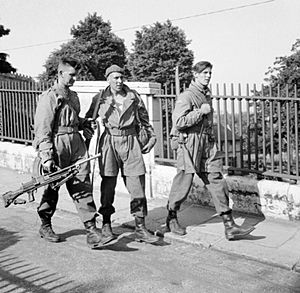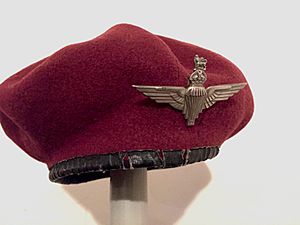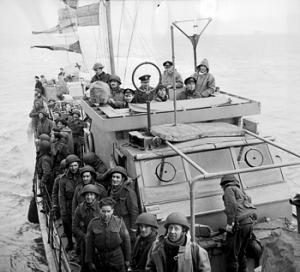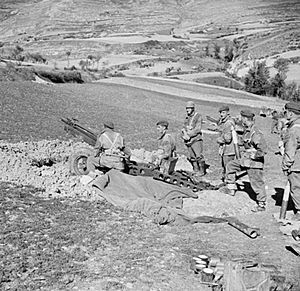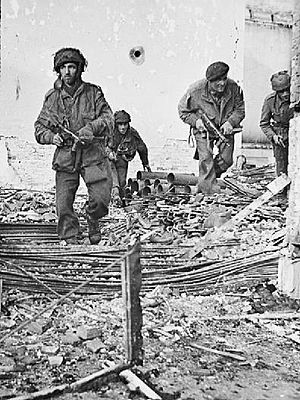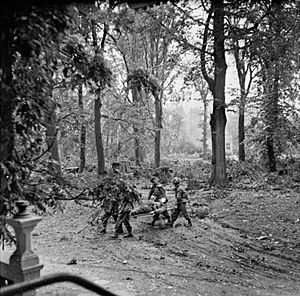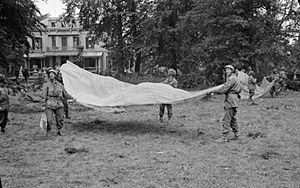1st Airborne Division (United Kingdom) facts for kids
Quick facts for kids 1st Airborne Division |
|
|---|---|

Men from the 1st Airborne Division during Operation Market Garden fighting in the battle of Arnhem, September 1944.
|
|
| Active | 1941–1945 |
| Country | |
| Branch | |
| Type | Infantry |
| Role | Airborne forces |
| Size | Division, 12,148 men |
| Part of | I Airborne Corps |
| Nickname(s) | Red Devils |
| Engagements | Operation Biting Operation Freshman Operation Turkey Buzzard Operation Ladbroke Operation Fustian Operation Slapstick Battle of Arnhem Operation Doomsday |
| Commanders | |
| Notable commanders |
Sir Frederick A.M. Browning George Hopkinson Roy Urquhart |
| Insignia | |
| Identification symbol |
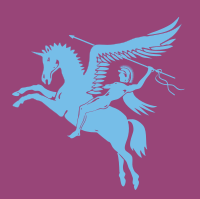 |
The 1st Airborne Division was a special group of soldiers in the British Army during the Second World War. These soldiers were trained to fight by dropping from planes, either by parachute or in gliders. The division was created in late 1941. This happened after the British Prime Minister, Winston Churchill, asked for a special airborne fighting force.
The division's first missions were quick attacks. One was Operation Biting, a parachute landing in France. Another was Operation Freshman, a glider mission in Norway. In late 1942, part of the division went to North Africa. There, they fought as regular infantry soldiers during the Tunisian campaign.
In July 1943, the division took part in the Allied invasion of Sicily. They made two large landings using gliders and parachutes. These missions, Operation Ladbroke and Operation Fustian, faced many problems. In September 1943, the 1st Airborne Division also made a landing in Italy. This was called Operation Slapstick.
Most of the division returned to England in December 1943. They began training for a big invasion in Europe. In September 1944, the 1st Airborne Division took part in Operation Market Garden. This was a huge plan to capture bridges in the Netherlands. The division landed far behind German lines. They fought bravely in the Battle of Arnhem. However, they could not reach their goals and faced heavy losses. After nine days, the remaining soldiers had to be rescued.
The division never fully recovered from the Battle of Arnhem. After the war ended in Europe, they went to Norway in May 1945. Their job was to disarm the German army there. The 1st Airborne Division returned to England and was officially closed down in November 1945.
Contents
Why were airborne forces created?
After seeing how well German airborne troops fought in France, British Prime Minister Winston Churchill wanted his own special force. He asked the army to look into creating 5,000 parachute soldiers. Because of this, in June 1940, a group called No. 2 Commando started training for parachute jumps. Later, it was renamed the 11th Special Air Service Battalion.
A special training center was also set up near Manchester. Its main job was to train parachute troops. But it also looked into using gliders to carry soldiers into battle. Soon, a company called General Aircraft Ltd was hired. They designed and built a glider called the General Aircraft Hotspur. This glider could carry eight soldiers.
The first successful British airborne raid, called Operation Colossus, showed what these forces could do. This led the army to create the Parachute Regiment. They also planned to turn regular infantry battalions into parachute and glider units. By May 1941, it was decided that Britain should have two parachute brigades and a glider force of 10,000 men.
How was the 1st Airborne Division formed?
The 11th Special Air Service Battalion became the 1st Parachute Battalion. Then, two new battalions were created: the 2nd and 3rd Parachute Battalions. Together, these three formed the 1st Parachute Brigade. Soldiers volunteered from other infantry units to join. They had to be between 22 and 32 years old.
In October 1941, Frederick "Boy" Browning was put in charge of forming and training airborne forces. The next unit created was the 1st Airlanding Brigade. This brigade was made from a mountain warfare unit. Its soldiers were also volunteers. By the end of 1941, Browning's command became the headquarters for the 1st Airborne Division.
Browning wanted a third brigade for the division. Permission was given in July 1942. The 2nd Parachute Brigade was then formed. It included the existing 4th Parachute Battalion and two new battalions. These new battalions were made from regular infantry units.
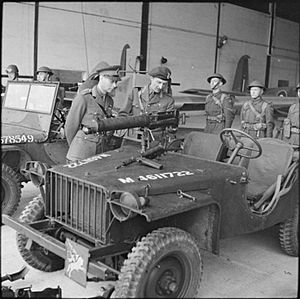
The 3rd Parachute Brigade was formed in November 1942. It also joined the 1st Airborne Division. Soon after, the 1st Parachute Brigade left the division. It went to North Africa for Operation Torch, a big Allied landing. There, they fought as regular infantry soldiers.
In April 1943, George Hopkinson took command of the division. Later that year, the division moved to Tunisia for operations in the Mediterranean. The 3rd Parachute Brigade and two battalions stayed in England. They became the start of a new unit, the 6th Airborne Division. When the 1st Airborne Division arrived in Tunisia, it was joined by the 4th Parachute Brigade. This brigade had been formed in the Middle East.

The division took part in two large operations in Sicily. They also made a sea landing at Taranto in Italy. During the fighting in Italy, Major General Hopkinson was badly wounded and died. Ernest Down became the new commander. After serving in the Mediterranean, the division returned to England in December 1943. The 2nd Parachute Brigade stayed behind in Italy.
The division from 1944 to 1945
After returning to England, Ernest Down went to India. Roy Urquhart then became the new commander of the division. In September 1944, for Operation Market Garden in the Netherlands, a Polish parachute brigade joined the division.
After Market Garden, fewer than 2,200 men out of 10,000 returned to British lines. The division had suffered huge losses. The 4th Parachute Brigade was closed down. Its remaining soldiers joined the 1st Parachute Brigade. The division tried to rebuild, but it never fully recovered. This was because there weren't enough new soldiers in the British Army. In May 1945, the division was sent to Norway. Their job was to disarm the German army there. The 1st Airborne Division then returned to Britain and was officially disbanded in November 1945.
What were their main operations?
The Bruneval Raid in France
Operation Biting, also known as the Bruneval Raid, was a secret mission in 1942. The goal was to capture a German radar machine at Bruneval in France. This radar was very important for the Germans. Attacking by sea would have been too risky. So, it was decided that airborne soldiers would parachute in. They would surprise the Germans and take the radar. Then, they would leave by sea.
On the night of February 27, soldiers from the 2nd Parachute Battalion parachuted into France. They attacked the building where the radar was kept. After a short fight, they captured it. A British technician with the group took apart the radar. He removed important pieces to take back to Britain. The soldiers then went to the beach to be picked up. They had another short fight to clear the beach. Then, small boats took them back to Britain. The mission was a complete success. The airborne troops had few casualties. The radar parts helped British scientists understand German technology. This allowed them to create ways to stop German radar.
The Norway mission: Operation Freshman
Operation Freshman was the first British airborne mission using gliders. Its target was a chemical plant in Norway. This plant made "heavy water" for Nazi Germany. By 1942, Germany was close to building a nuclear reactor. This reactor needed a lot of heavy water. So, the British decided to destroy the plant.
Many ideas were discussed. Finally, it was decided that 30 engineers from the Royal Engineers would land by glider. They would blow up the plant with explosives. Two planes, each pulling a glider, left Scotland on November 19, 1942. They reached the Norwegian coast, but none reached their target.
The first plane and glider had bad weather and navigation problems. The tow rope broke, and the glider crashed. Eight soldiers died, four were badly hurt, and five were unhurt. The survivors were captured. The second plane and glider crashed into a mountain. The crew and several soldiers died. Those who survived were captured. None of the captured soldiers lived long. They were either poisoned or executed by the Germans. This was due to Adolf Hitler's "Commando Order." This order said that all British Commando soldiers should be killed if captured.
Fighting in Sicily
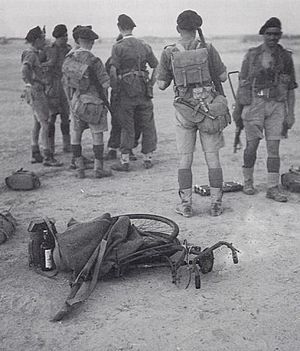
Operation Turkey Buzzard was a mission to deliver supplies to North Africa. It happened between March and August 1943. This mission was part of getting ready for the Allied invasion of Sicily. Large Horsa gliders were needed for the invasion. They were towed 3,200 miles from England to Tunisia. During the mission, five Horsa gliders and three towing planes were lost. But 27 Horsas made it to Tunisia in time for the invasion.
Operation Ladbroke was a glider attack near Syracuse. It started on July 9, 1943, as part of the Sicily invasion. The goal was to land near Syracuse, capture the Ponte Grande Bridge, and take control of the city's important docks. On the way to Sicily, 65 gliders were released too early. They crashed into the sea, and about 252 men drowned. Only 87 men reached the Pont Grande Bridge. They captured it and held it. But with no ammunition left and only 15 unwounded soldiers, they surrendered to Italian forces. The Italians tried to blow up the bridge, but they couldn't. The airborne soldiers had removed the explosives. Other troops from the brigade destroyed communication lines and captured enemy guns.
Operation Fustian was the division's second mission in Sicily. It was carried out by the 1st Parachute Brigade. Their target was the Primosole Bridge over the Simeto River. The plan was for paratroopers and glider troops to land on both sides of the river. One group would seize the bridge. The others would set up defenses. They would hold the bridge until other British forces arrived.
The start of the operation was a disaster. Many planes carrying paratroopers were shot down or turned back. This was due to both friendly fire and enemy attacks. The pilots had to fly in ways that scattered the soldiers over a large area. Only a small number of troops landed in the correct spots. Despite this, and facing German and Italian forces, the British paratroopers captured the bridge. They fought off attacks until nightfall.
The other British forces were slow to reach the paratroopers. By then, the paratroopers had many casualties and were running out of supplies. Their commander gave up control of the bridge to the Germans. The next day, British units joined up. They recaptured the bridge three days after the operation began.
Landing in Italy
Operation Slapstick was a sea landing at the Italian port of Taranto. It was part of the Allied invasion of Italy in September 1943. This mission was planned quickly. The Italian government offered to open the ports of Taranto and Brindisi to the Allies. The 1st Airborne Division was chosen for the mission. But they were in North Africa. There weren't enough transport planes for them to land by air. All the landing boats were already being used for other invasions. So, the division had to be carried across the Mediterranean by Royal Navy ships.
The landing faced no resistance. The airborne division successfully captured the ports of Taranto and Brindisi. The only German forces in the area were small groups. They fought the British with ambushes as they retreated north. By the end of September, the 1st Airborne Division had advanced 125 miles to Foggia. Other infantry divisions arrived to support them. This allowed the airborne troops to return to Taranto. The 1st Airborne Division had light casualties in Italy. However, their commander, Major-General George Hopkinson, was killed. He was watching an attack when he was shot by machine gun fire. Ernest Down became the new commander.
Training and plans in England
By December 1943, the division was back in England. They started training for operations in North-West Europe. The 1st Airborne Division was not planned to be part of the Normandy landings. But there was a backup plan. If there were big problems during the landings, the division would parachute in to help. This plan was not needed.
While another airborne division was fighting in Normandy, many plans were made for the 1st Airborne Division to parachute into France. But none of these plans happened. For example, Operation Reinforcement was to help American airborne troops. Operation Wild Oats was to capture a city. Operation Beneficiary was to help American forces capture a port. Operation Lucky Strike was to seize bridges. All these plans were cancelled.
By August, the division was still waiting to be used. New plans involved them as part of a larger force. Operation Transfigure aimed to close a gap between cities. Operation Axehead was to seize bridges over a river. Operation Boxer was to capture a port and attack German rocket sites. Near the end of August, Operation Linnet was planned to seize river crossings. Operation Infatuate was to trap German armies in Belgium.
Finally, in September, there was Operation Comet. In this plan, the division's three brigades would land in the Netherlands. Each would capture a river crossing. These were bridges over the River Waal, River Maas, and River Rhine. Planning for Comet was well underway. But on September 10, the mission was cancelled. Instead, a new, bigger operation was proposed. It had the same goals but would use three divisions.
The Battle of Arnhem
Operation Market Garden was a huge airborne attack in the Netherlands in September 1944. It involved three divisions: the British 1st and two American divisions. Their goal was to secure key bridges and towns. The British 1st Airborne, with Polish support, landed at Arnhem. They were to capture bridges across the Nederrijn. The plan was for ground troops to reach them in two to three days.
The 1st Airborne landed some distance from its targets. They quickly faced strong, unexpected German resistance. Only a small group reached the Arnhem road bridge. The main part of the division was stopped outside the city. Meanwhile, the ground troops could not advance as quickly as planned. They failed to reach the airborne troops. After four days, the small British force at the bridge was defeated. The rest of the division became trapped in a small area north of the river. They could not get enough help from the Polish troops or the ground forces. After nine days of fighting, the remaining airborne soldiers were pulled back south of the Rhine. The 1st Airborne Division lost 8,000 men in the battle. They never fought in combat again.
Post-war duties in Norway
In May 1945, right after the war in Europe ended, the 1st Airborne Division went to Norway. Their job was to disarm and send home the 350,000 German soldiers who had occupied Norway. The division kept law and order until other forces arrived. They supervised the surrender of German troops. They also made sure important buildings were not destroyed.
The German surrender was given on May 8. The 1st Airborne Division landed near Oslo and Stavanger between May 9 and 11. Most of the planes landed safely. But one crash caused several deaths. The division faced little German resistance. Their duties included welcoming back King Haakon. They also cared for Allied prisoners of war. They arrested war criminals and supervised the clearing of minefields. While in Norway, the division also investigated what happened to the airborne troops from Operation Freshman. The division returned to Britain. It was officially disbanded on August 26, 1945.
Who were the commanders and units?
Commanders
- 1943—1944 Major General Sir Frederick Arthur Montague Browning
- 1944—1945 Major General Robert Elliott Urquhart
Main Units
- 1st Parachute Brigade
- 1st Airlanding Brigade
- 2nd Parachute Brigade
- 3rd Parachute Brigade
- 4th Parachute Brigade
Other important units
- Divisional headquarters and signal squadron
- 1st Airlanding Light Regiment, Royal Artillery (artillery unit)
- 1st Airlanding Anti-Tank Regiment, Royal Artillery (anti-tank unit)
- 21st Independent Parachute Company, Army Air Corps (pathfinders)
- 1st Airborne Reconnaissance Squadron (scouting unit)
- 9th (Airborne) Field Company, Royal Engineers (engineer unit)
- 250th (Airborne) Light Company, Royal Army Service Corps (supply unit)
- 1st Airborne Division, Provost Company, Royal Military Police (military police)
See also
- Theirs is the Glory (a film about Arnhem)
- List of British divisions in World War II


